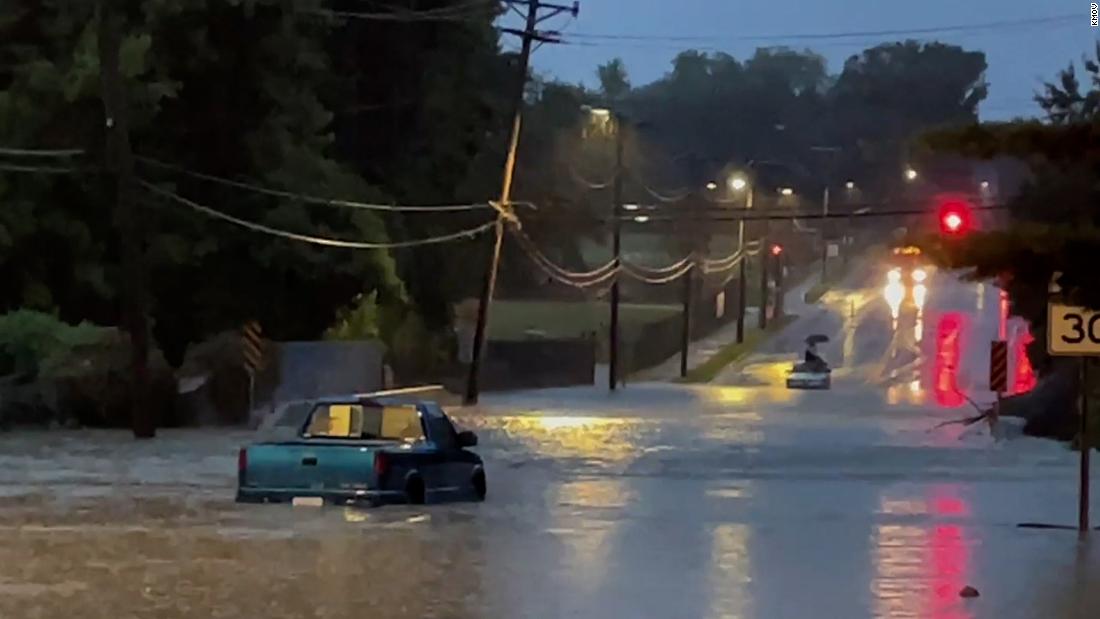One person was found dead in a vehicle that had become stuck in “approximately eight and a half” feet of water in western St. Louis, city Fire Chief Dennis Jenkerson said. Authorities checked the vehicle after a caller reported that someone may be inside, and found the body when waters receded, the chief said.
Floodwater surrounded vehicles on other St. Louis-area streets and crept up to apartments and other buildings, videos on social media showed.
A rescuer in St. Louis, kneeling on the top of the roof of one flooded car, handed a child to other rescuers in a boat, video recorded by Victorria Adams from an apartment balcony showed. “My neighbors woke me up to tell me what was going on. Then I walked out to all of this,” Adams told CNN of the floodwaters that made the street outside her apartment a virtual river.
“I carried all three of my dogs, three kids, and wife out,” Schafer told KMOV.
Emergency calls in St. Louis County were coming in “for multiple people stuck” in floodwaters, the county emergency management office said.
“We urge everybody to avoid travel!” the office posted to Twitter, adding central portions of the county were affected most.
MetroLink’s outdoor Forest Park-DeBaliviere station just north of the city’s zoo was underwater, images from resident Tony Nipert show. He noticed the flooding while walking his dogs, he told CNN.
Heather Taylor, St. Louis public safety director, said highways were mostly clear as of Tuesday afternoon and all bridges over the River des Peres are currently open.
“While we hope the worst is behind us, we want to keep the public informed,” she said. “Highways are mostly clear. Avoid the highways if you can. That is critical with this rain … Parts of Highway 70, I believe, are all open as well, but they may be closed again due to additional rainfall.”
In the St. Louis suburb of Florissant, a fire department crew helped Leisha Waters and her children from their apartment building Tuesday after floodwaters surrounded it, she told CNN.
“I was in the house with the window open to get light because the power went out, and I heard the fireman on a boat yelling,” Waters said. “So me and my kids packed a bag and left.”
Power was out for more than 10,000 homes and businesses in St. Charles and St. Louis counties, most of them in the
Floodwaters also were collecting on the Illinois side of the Mississippi River, including the East St. Louis area, where parts of interstate highways or their ramps were temporarily closed, the weather service said.
St. Louis Fire Chief Dennis M. Jenkerson said Tuesday firefighters “went on about 70 different rescue assists of civilians in the area. We’ve had a tremendous amount of cars that have been door deep and also roof deep in some of these low-lying areas.”
The chief said while the water has receded “a little bit, now we are seeing the weight of the water caused some issues with buildings.”
“We’re having some partial roof collapse. Some of the vacant buildings are also suffering from the stress of this water,” he said. “There was a significant area over around … McCausland and Southwest where we had right around 14 to 15 homes that suffered significant flooding.”
Stretch of I-70 covered by water and parts of other interstates also closed
A stretch of I-70 was closed in both directions before sunrise in St. Peters, roughly a 30-mile drive northwest of St. Louis.
Jerome Smith found himself stuck on that part of I-70 for three hours as workers tried to clear drains, he told CNN. The highway was covered by water, which was held in by barriers on either side, video he recorded from his vehicle shows.
“You can see there’s cars up there floating around. … It’s just all boxed in — there’s nowhere for the water to go,” Smith says in the video.
Rainfall this intense in the St. Louis area only occurs once every 500 years, on average, according to data from the weather service.
CNN’s Melissa Alonso, Judson Jones, Dave Hennen, Angela Fritz and Raja Razek contributed to this report.



